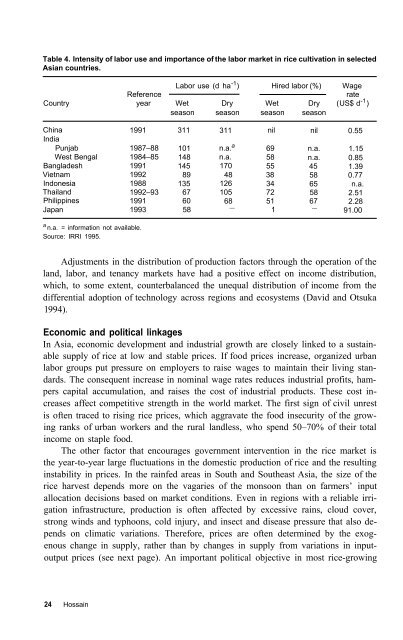Sustainability of rice in the global food system - IRRI books
Sustainability of rice in the global food system - IRRI books
Sustainability of rice in the global food system - IRRI books
Create successful ePaper yourself
Turn your PDF publications into a flip-book with our unique Google optimized e-Paper software.
Table 4. Intensity <strong>of</strong> labor use and importance <strong>of</strong> <strong>the</strong> labor market <strong>in</strong> <strong>rice</strong> cultivation <strong>in</strong> selected<br />
Asian countries.<br />
Labor use (d ha -1 ) Hired labor (%) Wage<br />
Reference<br />
rate<br />
Country year Wet Dry Wet Dry ( US$ d -1 )<br />
season season season season<br />
Ch<strong>in</strong>a<br />
India<br />
Punjab<br />
West Bengal<br />
Bangladesh<br />
Vietnam<br />
Indonesia<br />
Thailand<br />
Philipp<strong>in</strong>es<br />
Japan<br />
1991<br />
1987–88<br />
1984–85<br />
1991<br />
1992<br />
1988<br />
1992–93<br />
1991<br />
1993<br />
311<br />
101<br />
148<br />
145<br />
89<br />
135<br />
67<br />
60<br />
58<br />
311<br />
n.a. a<br />
n.a.<br />
170<br />
48<br />
126<br />
105<br />
68<br />
–<br />
nil<br />
69<br />
58<br />
55<br />
38<br />
34<br />
72<br />
51<br />
1<br />
nil<br />
n.a.<br />
n.a.<br />
45<br />
58<br />
65<br />
58<br />
67<br />
–<br />
0.55<br />
1.15<br />
0.85<br />
1.39<br />
0.77<br />
n.a.<br />
2.51<br />
2.28<br />
91.00<br />
a n.a. = <strong>in</strong>formation not available.<br />
Source: <strong>IRRI</strong> 1995.<br />
Adjustments <strong>in</strong> <strong>the</strong> distribution <strong>of</strong> production factors through <strong>the</strong> operation <strong>of</strong> <strong>the</strong><br />
land, labor, and tenancy markets have had a positive effect on <strong>in</strong>come distribution,<br />
which, to some extent, counterbalanced <strong>the</strong> unequal distribution <strong>of</strong> <strong>in</strong>come from <strong>the</strong><br />
differential adoption <strong>of</strong> technology across regions and eco<strong>system</strong>s (David and Otsuka<br />
1 994).<br />
Economic and political l<strong>in</strong>kages<br />
In Asia, economic development and <strong>in</strong>dustrial growth are closely l<strong>in</strong>ked to a susta<strong>in</strong>able<br />
supply <strong>of</strong> <strong>rice</strong> at low and stable p<strong>rice</strong>s. If <strong>food</strong> p<strong>rice</strong>s <strong>in</strong>crease, organized urban<br />
labor groups put pressure on employers to raise wages to ma<strong>in</strong>ta<strong>in</strong> <strong>the</strong>ir liv<strong>in</strong>g standards.<br />
The consequent <strong>in</strong>crease <strong>in</strong> nom<strong>in</strong>al wage rates reduces <strong>in</strong>dustrial pr<strong>of</strong>its, hampers<br />
capital accumulation, and raises <strong>the</strong> cost <strong>of</strong> <strong>in</strong>dustrial products. These cost <strong>in</strong>creases<br />
affect competitive strength <strong>in</strong> <strong>the</strong> world market. The first sign <strong>of</strong> civil unrest<br />
is <strong>of</strong>ten traced to ris<strong>in</strong>g <strong>rice</strong> p<strong>rice</strong>s, which aggravate <strong>the</strong> <strong>food</strong> <strong>in</strong>security <strong>of</strong> <strong>the</strong> grow<strong>in</strong>g<br />
ranks <strong>of</strong> urban workers and <strong>the</strong> rural landless, who spend 50–70% <strong>of</strong> <strong>the</strong>ir total<br />
<strong>in</strong>come on staple <strong>food</strong>.<br />
The o<strong>the</strong>r factor that encourages government <strong>in</strong>tervention <strong>in</strong> <strong>the</strong> <strong>rice</strong> market is<br />
<strong>the</strong> year-to-year large fluctuations <strong>in</strong> <strong>the</strong> domestic production <strong>of</strong> <strong>rice</strong> and <strong>the</strong> result<strong>in</strong>g<br />
<strong>in</strong>stability <strong>in</strong> p<strong>rice</strong>s. In <strong>the</strong> ra<strong>in</strong>fed areas <strong>in</strong> South and Sou<strong>the</strong>ast Asia, <strong>the</strong> size <strong>of</strong> <strong>the</strong><br />
<strong>rice</strong> harvest depends more on <strong>the</strong> vagaries <strong>of</strong> <strong>the</strong> monsoon than on farmers’ <strong>in</strong>put<br />
allocation decisions based on market conditions. Even <strong>in</strong> regions with a reliable irrigation<br />
<strong>in</strong>frastructure, production is <strong>of</strong>ten affected by excessive ra<strong>in</strong>s, cloud cover,<br />
strong w<strong>in</strong>ds and typhoons, cold <strong>in</strong>jury, and <strong>in</strong>sect and disease pressure that also depends<br />
on climatic variations. Therefore, p<strong>rice</strong>s are <strong>of</strong>ten determ<strong>in</strong>ed by <strong>the</strong> exogenous<br />
change <strong>in</strong> supply, ra<strong>the</strong>r than by changes <strong>in</strong> supply from variations <strong>in</strong> <strong>in</strong>putoutput<br />
p<strong>rice</strong>s (see next page). An important political objective <strong>in</strong> most <strong>rice</strong>-grow<strong>in</strong>g<br />
24 Hossa<strong>in</strong>

















